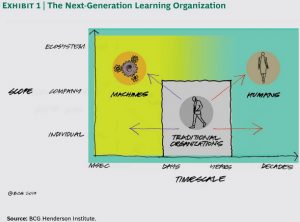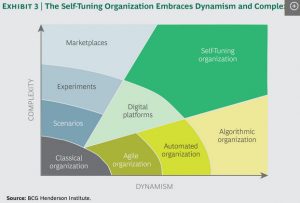In the coming decade, companies will increasingly need to compete on the rate of learning. Technology promises to play a critical role: artificial intelligence can detect patterns in complex data sets at extreme speed and scale, enabling dynamic learning. This will allow organizations to constantly adapt to changing realities and surface new opportunities, which will be increasingly important in an uncertain and fast-changing environment.
But for companies to compete on learning, it is not enough to merely adopt AI, which alone can accelerate learning only in individual activities. As with previous transformative technologies, unlocking the full potential of AI—and of humans—will require fundamental organizational innovation.
In other words, to win the ’20s, leaders will need to re-invent the enterprise as a next-generation learning organization.
The next-generation learning organization will need to be redesigned to fulfill several key functions: (See Exhibit 1.)
- Learning on All Timescales. The growing opportunity and need to learn on faster timescales, driven by technological innovation, is well known—algorithmic trading, dynamic pricing, and real-time customized product recommendations are already a reality in many businesses. But it is perhaps under-appreciated that slow-moving forces are also becoming more important. For example, trade institutions, political structures, wealth stratification, and social attitudes are slowly changing in ways that could have a profound impact on business. Gone are the days when business leaders could focus only on business and treat these broader variables as constants or stable trends. But such shifts unfold over many years or even decades. In order to thrive sustainably, businesses must learn on all timescales simultaneously.
- Combining Humans and Machines Optimally. Machines have been crucial components of businesses for centuries—but in the AI age, they will likely expand rapidly into what has traditionally been considered white-collar work. Instead of merely executing human-directed and designed processes, machines will be able to learn and adapt, and will therefore have a greatly expanded role in future organizations. Humans will still be indispensable, but their duties will be quite different when complemented or substituted by intelligent machines.
- Integrating Economic Activity Beyond Corporate Boundaries. Businesses are increasingly acting in multicompany ecosystems that incorporate a wide variety of players. Indeed, seven of the world’s largest companies, and many of the most profitable ones, are now platform businesses. Ecosystems greatly expand learning potential: they provide access to exponentially more data, they enable rapid experimentation, and they connect with larger networks of suppliers of customers. Harnessing this potential requires redrawing the boundaries of the enterprise and effectively influencing economic activity beyond the orchestrating company.
- Evolving the Organization Continuously. The need for dynamic learning does not apply just to customer-facing functions—it also extends to the inner workings of the enterprise. To take advantage of new information and to compete in dynamic, uncertain environments, the organizational context itself needs to be evolvable in the face of changing external conditions.
- By reconceiving the external and internal workings of the organization as a flexible, evolving ecosystem, businesses can handle much greater dynamism and complexity. This requires subjecting all aspects of the organization to market forces, enabling it to learn and adapt in response to new opportunities. And it requires internal systems that adjust automatically to new information, allowing learning and resource reallocation to occur at algorithmic speed. When combined, these capabilities can create a “self-tuning enterprise” that constantly learns and evolves according to its environment. (See Exhibit 3.)To harness the power of ecosystems throughout and beyond the organization, leaders must:
- Engage external partners to create a shared vision of the future.
- Develop capabilities for collaboration and information sharing at scale—for example, platforms and APIs.
- Redesign internal processes to be more adaptive and data-driven, allowing the organization to become “self-tuning.”
…
By reconceiving the external and internal workings of the organization as a flexible, evolving ecosystem, businesses can handle much greater dynamism and complexity. This requires subjecting all aspects of the organization to market forces, enabling it to learn and adapt in response to new opportunities. And it requires internal systems that adjust automatically to new information, allowing learning and resource reallocation to occur at algorithmic speed. When combined, these capabilities can create a “self-tuning enterprise” that constantly learns and evolves according to its environment. (See Exhibit 3.)
To harness the power of ecosystems throughout and beyond the organization, leaders must:
- Engage external partners to create a shared vision of the future.
- Develop capabilities for collaboration and information sharing at scale—for example, platforms and APIs.
- Redesign internal processes to be more adaptive and data-driven, allowing the organization to become “self-tuning.”
By Allison Bailey, Martin Reeves, Kevin Whitaker, and Rich Hutchinson
More: BCG https://www.bcg.com/
The BCG Henderson Institute is Boston Consulting Group’s strategy think tank, dedicated to exploring and developing valuable new insights from business, technology, and science by embracing the powerful technology of ideas. The Institute engages leaders in provocative discussion and experimentation to expand the boundaries of business theory and practice and to translate innovative ideas from within and beyond business. For more ideas and inspiration from the Institute, please visit Featured Insights.

